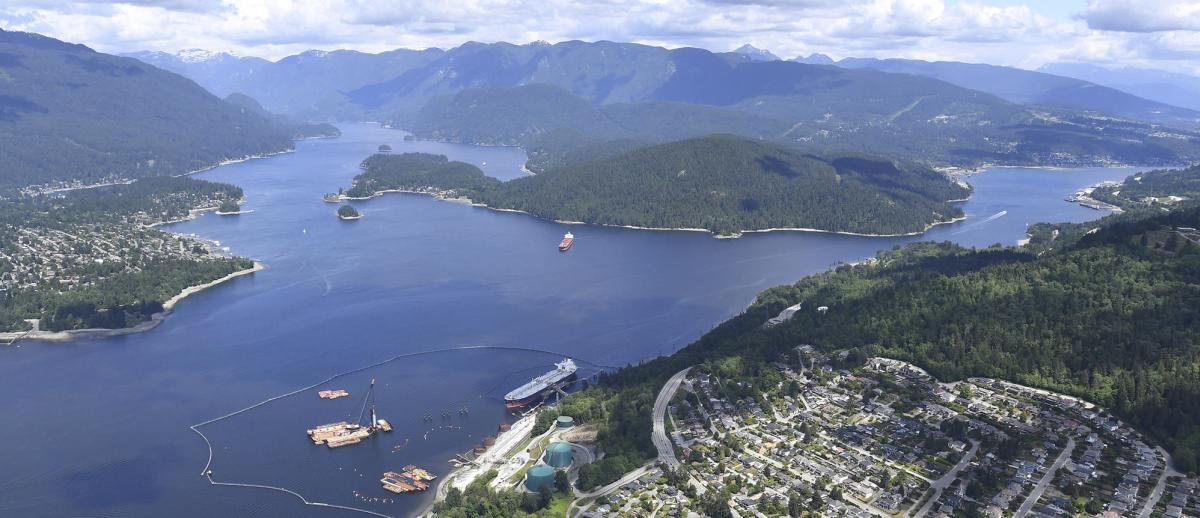The End of Canada?
archive


terminus of the Trans Mountain Pipeline in Burnaby, British Columbia.
The End of Canada?
When Canada was formed as a nation just over 150 years ago, it became a member of the international system of states that has proved remarkably durable since its Westphalian origins in the seventeenth century. Certainly, some states have divided, usually accompanied by bloodshed, some have failed in the sense that they are unable to provide the security required for a state to be regarded as functioning. But, for the most part, nation states have proved resilient and continue to be central agents on the international landscape, notwithstanding some of the more fanciful predictions of pro-globalists who saw fit to declare the ‘end of the state’.
And yet, it is worth asking whether, taking a longer view, we can expect nation states to continue to exist in the ways in which they do today. This is too broad a question to be answered here but I do want to make the provocative case that Canada may be a state whose future is far from assured. Good old, boring, UN supporting, middle power Canada. Why would anyone predict that in another 150 years Canada may not be around?
The answer I will give is not directly connected to Quebec sovereignty, a force that nearly led to the break-up of Confederation in the Quebec referenda of 1980 and 1995. The answer is rather to be found in the present failure of Canada to escape from a staple—fossil fuels—whose time is up.
At the time of Confederation in 1867, Canada as a nation was carved out of the imperial rivalries of two European powers (Britain and France) and situated uncomfortably close to an assertive emerging industrial power, the United States, even if it was in the almost dying throes of a civil war. Indigenous nations were subsumed, or worse, within the colonializing project of the young state. The Indian Act, or more accurately a series of policies and legislation from the 1890s onwards, ensured their on-going subjugation from which many have yet to escape.
Underpinning the unstable political conditions present at Canada’s formation were strong economic forces. In fact, from the 1700s onwards the land which was to become Canada had been a supplier of staples to the European powers. Staples—that is, natural resources destined for export—formed the bedrock of Canadian economic development. The staples approach, pioneered by Harold Innis, sought to analyze how staples developed and what political and economic implications led from them.1 Innis’s most famous case study was that of the fur trade. There he traced how Indigenous nations were included as valuable participants in the economy of catching, trading, and exporting pelts to satisfy European demand, as well as the role of European financial capital in enabling the trade to prosper. As the staple changed so did the usefulness of Indigenous nations, and soon they were excluded from the economic mainstream. After the fur staple came wood, then wheat as the prairies were opened up to colonial settlement in the 1890s. Innis, writing in the 1920s, was one of the first scholars to posit the interdependent relationship between the “frontier” and “backtier,” anticipating the work of postcolonial scholars by several decades.
With the neighboring United States becoming the world’s largest industrial nation and with European powers beset by wars, including two World Wars, demand for raw materials was high and Canada was able to extend its role as a supplier of staples to the world well into the 20th century. Industrialization did gain strength in the post-1945 period as steel, petrochemicals, machinery, and automobile production took strong hold, the latter partly as a result of the Auto Pact of the 1960s which integrated Canadian and US production. All of this led to the demise of the ‘staples economy’ characterization of Canada, which is still relevant to some rural and remote regions but no longer accurate as a descriptor of Canada’s main economic drivers. Indeed, the discussion shifted to the foreign ownership of Canadian industry with the limitations of its “branch plant” status and the “silent surrender,” as Kari Polanyi Levitt famously called it, of Canada’s industry as highlighted by left nationalists.2
But then something unexpected happened. The long commodities boom of the first decade and a half of the 21st century, driven in large part by demand from China, resulted in a spectacular comeback for the commodity sector in Canada. From being a symbol of the “old economy,” a sector dying in the face of the new knowledge economy, suddenly Canada was being touted by its Prime Minister as an “energy superpower.” Stephen Harper’s memorable phrase may have been an exaggeration but it did capture the mood of confidence in, and for, an oil sector expanding in the tar sands of Alberta. Canada is now the fifth largest net energy exporter in the world and energy exports (overwhelmingly oil and natural gas) make up nearly a quarter of total Canadian goods exports.3
The long commodities boom of the first decade and a half of the 21st century… resulted in a spectacular comeback for the commodity sector in Canada.
Canada’s pro-oil lobby groups, joined by the Canadian government, managed to get the European Union not to classify tar sands oil as “dirty” and did its best to promote it as “ethical oil” coming from a reliable democratic country rather than unstable and repressive regimes such as those in the Gulf and Venezuela. The problem is that land-locked Alberta needs to get its oil to market and needs an expansion of pipelines if the corporations investing in the tar sands are to increase their production levels in the ways they plan. A potential doubling of output by 2030, the industry’s declared goal, requires greater pipeline capacity and a concerted effort on all fronts by Canadian governments is underway to achieve this end. It has meant lobbying the US government over the past decade to approve the Keystone XL project. At the same time, it has meant declaring that exporting more oil to the US is not actually in Canada’s interests because of the price discount, and that opening markets to Asia is critical. The Trans Mountain Pipeline expansion, designed to triple oil flows to tidewater on Canada’s west coast, has met with substantial opposition from Indigenous and environmental groups in British Columbia as well as from the province’s government itself. Faced with this opposition and lawsuits, the owner of the project, Kinder Morgan, decided to sell its holdings—and found a willing buyer in the Government of Canada. 4.5 billion dollars later, Canadian citizens now own the pipeline project.
But for some provincial governments such as that of Alberta, and for oil corporations, even that step isn’t enough. They want faster action to force through new pipelines. Declaring that without stronger action Alberta will have to reconsider its place in Confederation. The oil industry’s (now rebranded as the “energy industry”) political supporters are campaigning against the Trudeau government prior to the October federal election. The Liberals’ crime seems to have been to support carbon taxes as part of an “extractive bargain” in which the party supports the further expansion of the tar sands if other green policies are also put in place. In an impressive act of cognitive dissonance, the current government declared a “climate emergency” at the same time as buying the Trans Mountain Pipeline.

Image source: TransMountain
But these current political skirmishes conceal a more profound underlying challenge for Canadian confederation. The two main political parties are not debating how to move away from fossil fuels, only the best way to maintain public support for their expansion. It was, after all, Prime Minister Trudeau who told an oil meeting in Texas in 2017 that “no country would find 173 billion barrels of oil in the ground and just leave them there.”4
Canadian politicians and policy makers are trapped in their support for a staple which will not be viable beyond two decades at the most. What then? Canada has no green industrial policy worthy of the name and has not invested in green technologies at anywhere near the same level as Germany, Denmark, South Korea, and China. It has not set up sovereign wealth funds like Norway or the UAE to transfer its temporary oil wealth into future revenues. Instead, it is doing what it has done for most of the past 150 years, namely, rely on exporting natural resources to the world market. Will there be a post-oil staple? Fresh water perhaps? Who knows, but it cannot be presumed. A nation with a short-sighted reliance on staples and beholden to the interests of large corporations which will flee as soon as the staple runs out does not have a secure future. A nation formed to provide imperial powers with resources but which fails to make a transition away from a staple which has no future may not have a future itself. Whether Canada is still around in another 150 years depends not on its ability to extract more oil in the present, but on its ability to develop an alternative to staples for the future. There is no sign at present that its political class can.
1. For the staples approach see, for example, Watkins, M., “The Innis Tradition in Canadian Political Economy,” Canadian Journal of Political and Social Theory, 6, Winter-Spring 1982, 12-34.
2. Levitt, K., Silent Surrender: The Multinational Corporation in Canada. Kingston: McGill-Queen’s University Press, 1970.
3. See https://www.nrcan.gc.ca/science-data/data-analysis/energy-data-analysis/...
4. Berke, J., “’No country would find 173 billion barrels of oil in the ground and just leave them': Justin Trudeau gets a standing ovation at an energy conference in Texas.” Business Insider, March 10, 2017,
http://www.businessinsider.com/trudeau-gets-a-standing-ovation-at-energy-industry-conference-oil-gas-2017-3.



